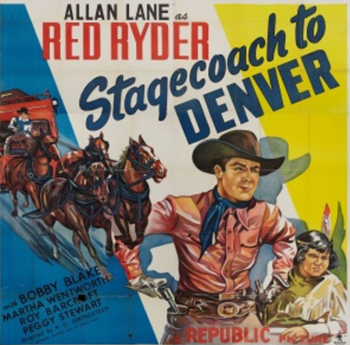Classic Movie Review: Stagecoach to Denver
A Look at the Old West
By Jason Barney
July 23, 2014
BoxOfficeProphets.com

It is a black and white film. Contrast this with too many explosions and excessive special effects that dull the senses. The colorless feature attracts the viewer the way salt and pepper enhance a meal. Black and white. Shades of gray. It is like sitting down and turning the pages of an old family album that holds memories and evokes feelings of times gone by.
The setting for Stagecoach to Denver is in the quiet hills and valleys of the old west, when the telegraph is snaking over the land. Denver is a central hub, but the mining communities and towns surrounding the city have yet to receive their lines. In Elkhorn, Colorado the people go about their business, tolerating everything moving in from the east, dealing with a recent collapse of silver mines, and seemingly no longer concerned with tensions with Native Americans. It is against this backdrop that the plot unfolds.
Local businessman Bill Lambert, who has built up a lot of good will in Elkhorn, is a wolf in sheep’s clothing. As Denver’s economic influence builds, he sees the land in the area as a slam dunk investment. He’s already established, and if he can get control of some important property, he will make a tidy profit. He doesn’t want to pay market value, though, and schemes to alter the land survey, effectively squeezing landowners off tracts they own.
The character of Bill Lambert, wonderfully played by Roy Barcroft, is one of the best in the film. You want to like him. Morality is certainly not his concern, but Barcroft’s portrayal is believable and enticing. He comes across as a politician locals believe is one of their own. In some respects he is like a used car salesmen - not the dishonest, lying one from a different town, but the guy your family has used many times over the years. Viewers feel like Bill Lambert has them in a firm, warm handshake. As his true villainous nature comes out, it is hard not to experience betrayal. It soon becomes apparent he has the scruples of a gang leader and the callousness of man consumed with greed.
If you have ever heard the saying your hero needs a good villain, Bill Lambert allows the rest of the film to flourish. Allan Lane plays Red Ryder, the thin, clean-shaven star who gets dragged into the eddies and currents of the land shenanigans. Red Ryder is about as straight and narrow as they come, a superhero without the powers or cape. He gets involved when Lambert’s cronies sabotage a stagecoach carrying the legitimate land commissioner out of town. In a gripping scene the carriage tumbles over a rock ledge, killing everyone but a child. The injured boy’s health is central to the plot.
Red Ryder, of course, becomes the big problem for Bill Lambert. Ryder saved the boy, he was the one who contacted the surviving relative, and locals talk with him about their sudden land issues.
Bill Lambert is so intent on making sure his land grab goes through that he kidnaps the child’s surviving family member and brings in other associates of his to move things along. One is a phony who falsifies signatures on property records; another is a woman who parades as the surviving child’s aunt. Lambert makes sure his relationship with the local sheriff is “mutually beneficial.”
The story unfolds, moral issues are explored, and the action heats up. There are a couple of well choreographed gun fights, a horse and stagecoach chase scene, and at least one good knuckles to bones fist fight. During all of these, the hero’s hat never falls off, many of the villains are clad in black, and the western scenery is as beautiful as a postcard.
Stagecoach to Denver isn’t perfect by any stretch of the imagination. Mechanically, the sound quality isn’t great. It was made in a time when only one version of history was told. The biggest example is the character of Little Beaver, a young Indian boy whom Red Ryder has befriended. The relationship leads viewers to believe this very nice white man took in Little Beaver, and the boy has no regrets or concerns about what happened to his ancestors or family. This point is worth making, but when compared with the mindlessness of much of today’s cinema, it can be used as a historical teaching tool. Westerns represent an epic time period in history, and analyzing the dated portrayal has value. Parents letting children watch a western with limited cultural views will have an easier time discussing its faults than explaining the gore of Deliver Us from Evil or the blunt dialogue in Tammy. Also, Red Ryder is almost too perfect, a cookie cutter caricature of the good guy common with many early westerns. Viewing Stagecoach to Denver gives you the impression that heroes are always flawless and that the world is just made up of right and wrong.
That said, Stagecoach to Denver is well worth viewing. For a film made over 65 years ago, it is fast paced, has plenty of twists and turns, and doesn’t take long to watch. A bad flick released today may consume over two hours of your time. This feature is only 56 minutes long, about the same as streaming popular television episodes.
Going to the movies can be very expensive. Some people are tired of opening their wallets to see robots battle, listen to raw jokes, and view excessive gore. With old movies like Stagecoach to Denver available to stream, movie fans can experience an almost forgotten genre of great American story telling.